Lesson Planning for Business and Economics Curriculum, Year 7-10
VerifiedAdded on 2022/12/27
|24
|4271
|54
Homework Assignment
AI Summary
This assignment presents a series of lesson plans designed for a Year 7-10 Business and Economics curriculum, focusing on developing effective teaching strategies and assessment methods. The solution comprises three lesson plans, each approximately 40 minutes long, demonstrating a cohesive sequence of learning. The plans incorporate a variety of lesson types, including practical and ICT components, to ensure continuity of learning. The first lesson explores painter's musical art, using guided questions and activities to assess student understanding and encourage abstract conceptualizations. The second lesson focuses on painter's tape art, teaching students to create designs and understand the significance of negative space. The final lesson delves into abstract and concrete reasoning through a discussion of pets and a debate on animal sales, promoting critical thinking and application of information. The assignment emphasizes lesson planning, classroom assessments, and the importance of activating prior knowledge to facilitate student engagement and achieve specific learning outcomes.
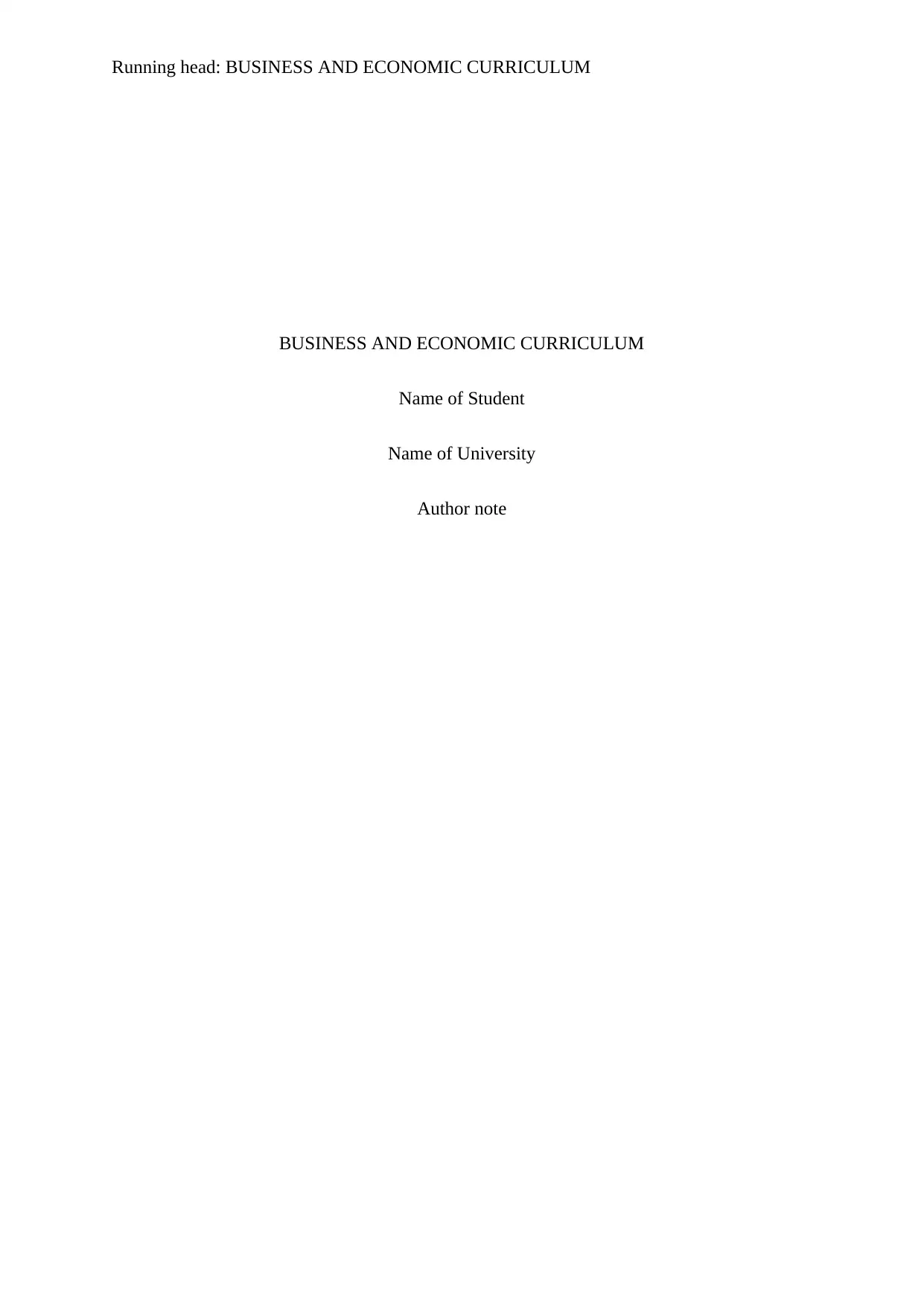
Running head: BUSINESS AND ECONOMIC CURRICULUM
BUSINESS AND ECONOMIC CURRICULUM
Name of Student
Name of University
Author note
BUSINESS AND ECONOMIC CURRICULUM
Name of Student
Name of University
Author note
Paraphrase This Document
Need a fresh take? Get an instant paraphrase of this document with our AI Paraphraser
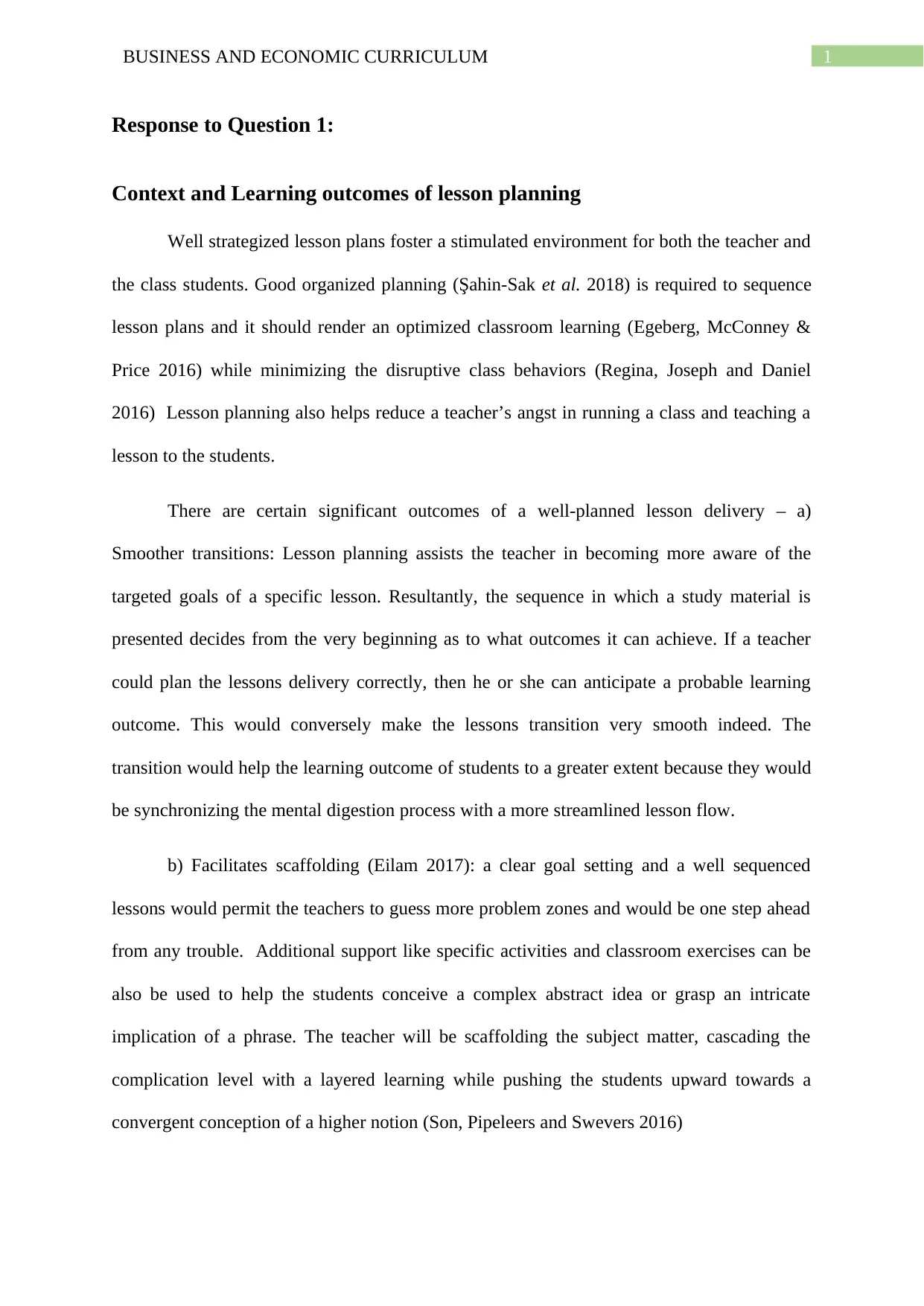
1BUSINESS AND ECONOMIC CURRICULUM
Response to Question 1:
Context and Learning outcomes of lesson planning
Well strategized lesson plans foster a stimulated environment for both the teacher and
the class students. Good organized planning (Şahin-Sak et al. 2018) is required to sequence
lesson plans and it should render an optimized classroom learning (Egeberg, McConney &
Price 2016) while minimizing the disruptive class behaviors (Regina, Joseph and Daniel
2016) Lesson planning also helps reduce a teacher’s angst in running a class and teaching a
lesson to the students.
There are certain significant outcomes of a well-planned lesson delivery – a)
Smoother transitions: Lesson planning assists the teacher in becoming more aware of the
targeted goals of a specific lesson. Resultantly, the sequence in which a study material is
presented decides from the very beginning as to what outcomes it can achieve. If a teacher
could plan the lessons delivery correctly, then he or she can anticipate a probable learning
outcome. This would conversely make the lessons transition very smooth indeed. The
transition would help the learning outcome of students to a greater extent because they would
be synchronizing the mental digestion process with a more streamlined lesson flow.
b) Facilitates scaffolding (Eilam 2017): a clear goal setting and a well sequenced
lessons would permit the teachers to guess more problem zones and would be one step ahead
from any trouble. Additional support like specific activities and classroom exercises can be
also be used to help the students conceive a complex abstract idea or grasp an intricate
implication of a phrase. The teacher will be scaffolding the subject matter, cascading the
complication level with a layered learning while pushing the students upward towards a
convergent conception of a higher notion (Son, Pipeleers and Swevers 2016)
Response to Question 1:
Context and Learning outcomes of lesson planning
Well strategized lesson plans foster a stimulated environment for both the teacher and
the class students. Good organized planning (Şahin-Sak et al. 2018) is required to sequence
lesson plans and it should render an optimized classroom learning (Egeberg, McConney &
Price 2016) while minimizing the disruptive class behaviors (Regina, Joseph and Daniel
2016) Lesson planning also helps reduce a teacher’s angst in running a class and teaching a
lesson to the students.
There are certain significant outcomes of a well-planned lesson delivery – a)
Smoother transitions: Lesson planning assists the teacher in becoming more aware of the
targeted goals of a specific lesson. Resultantly, the sequence in which a study material is
presented decides from the very beginning as to what outcomes it can achieve. If a teacher
could plan the lessons delivery correctly, then he or she can anticipate a probable learning
outcome. This would conversely make the lessons transition very smooth indeed. The
transition would help the learning outcome of students to a greater extent because they would
be synchronizing the mental digestion process with a more streamlined lesson flow.
b) Facilitates scaffolding (Eilam 2017): a clear goal setting and a well sequenced
lessons would permit the teachers to guess more problem zones and would be one step ahead
from any trouble. Additional support like specific activities and classroom exercises can be
also be used to help the students conceive a complex abstract idea or grasp an intricate
implication of a phrase. The teacher will be scaffolding the subject matter, cascading the
complication level with a layered learning while pushing the students upward towards a
convergent conception of a higher notion (Son, Pipeleers and Swevers 2016)
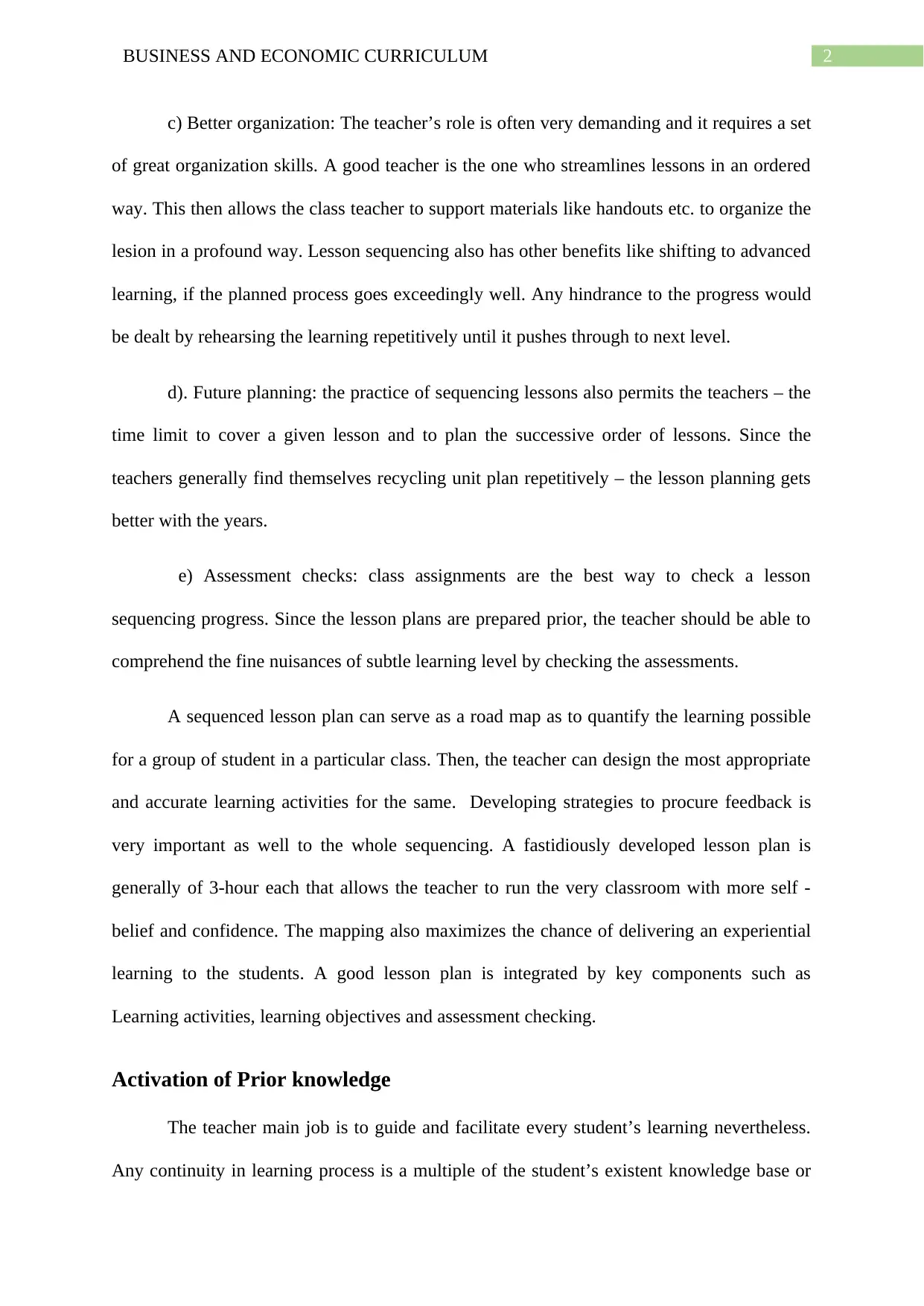
2BUSINESS AND ECONOMIC CURRICULUM
c) Better organization: The teacher’s role is often very demanding and it requires a set
of great organization skills. A good teacher is the one who streamlines lessons in an ordered
way. This then allows the class teacher to support materials like handouts etc. to organize the
lesion in a profound way. Lesson sequencing also has other benefits like shifting to advanced
learning, if the planned process goes exceedingly well. Any hindrance to the progress would
be dealt by rehearsing the learning repetitively until it pushes through to next level.
d). Future planning: the practice of sequencing lessons also permits the teachers – the
time limit to cover a given lesson and to plan the successive order of lessons. Since the
teachers generally find themselves recycling unit plan repetitively – the lesson planning gets
better with the years.
e) Assessment checks: class assignments are the best way to check a lesson
sequencing progress. Since the lesson plans are prepared prior, the teacher should be able to
comprehend the fine nuisances of subtle learning level by checking the assessments.
A sequenced lesson plan can serve as a road map as to quantify the learning possible
for a group of student in a particular class. Then, the teacher can design the most appropriate
and accurate learning activities for the same. Developing strategies to procure feedback is
very important as well to the whole sequencing. A fastidiously developed lesson plan is
generally of 3-hour each that allows the teacher to run the very classroom with more self -
belief and confidence. The mapping also maximizes the chance of delivering an experiential
learning to the students. A good lesson plan is integrated by key components such as
Learning activities, learning objectives and assessment checking.
Activation of Prior knowledge
The teacher main job is to guide and facilitate every student’s learning nevertheless.
Any continuity in learning process is a multiple of the student’s existent knowledge base or
c) Better organization: The teacher’s role is often very demanding and it requires a set
of great organization skills. A good teacher is the one who streamlines lessons in an ordered
way. This then allows the class teacher to support materials like handouts etc. to organize the
lesion in a profound way. Lesson sequencing also has other benefits like shifting to advanced
learning, if the planned process goes exceedingly well. Any hindrance to the progress would
be dealt by rehearsing the learning repetitively until it pushes through to next level.
d). Future planning: the practice of sequencing lessons also permits the teachers – the
time limit to cover a given lesson and to plan the successive order of lessons. Since the
teachers generally find themselves recycling unit plan repetitively – the lesson planning gets
better with the years.
e) Assessment checks: class assignments are the best way to check a lesson
sequencing progress. Since the lesson plans are prepared prior, the teacher should be able to
comprehend the fine nuisances of subtle learning level by checking the assessments.
A sequenced lesson plan can serve as a road map as to quantify the learning possible
for a group of student in a particular class. Then, the teacher can design the most appropriate
and accurate learning activities for the same. Developing strategies to procure feedback is
very important as well to the whole sequencing. A fastidiously developed lesson plan is
generally of 3-hour each that allows the teacher to run the very classroom with more self -
belief and confidence. The mapping also maximizes the chance of delivering an experiential
learning to the students. A good lesson plan is integrated by key components such as
Learning activities, learning objectives and assessment checking.
Activation of Prior knowledge
The teacher main job is to guide and facilitate every student’s learning nevertheless.
Any continuity in learning process is a multiple of the student’s existent knowledge base or
⊘ This is a preview!⊘
Do you want full access?
Subscribe today to unlock all pages.

Trusted by 1+ million students worldwide
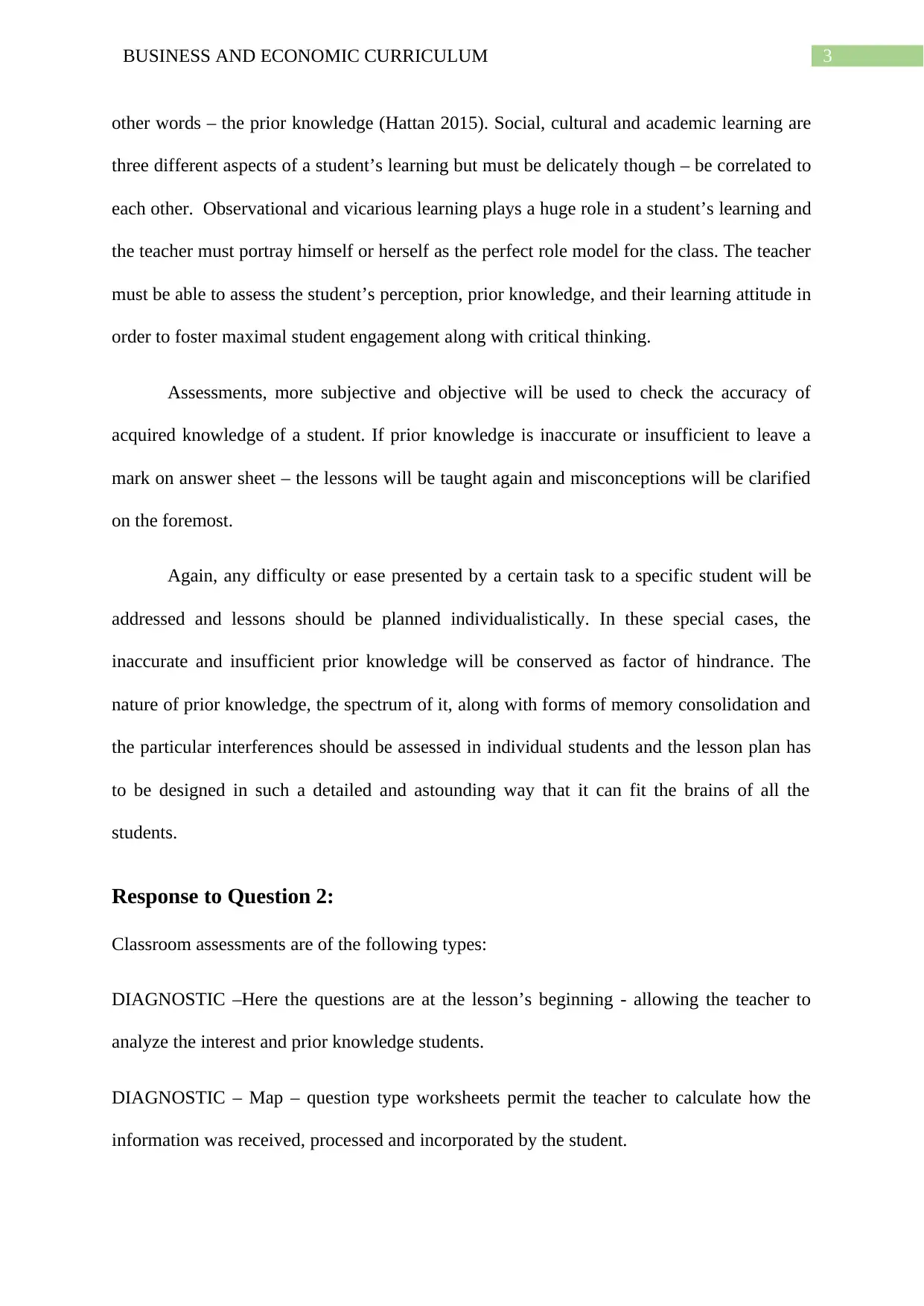
3BUSINESS AND ECONOMIC CURRICULUM
other words – the prior knowledge (Hattan 2015). Social, cultural and academic learning are
three different aspects of a student’s learning but must be delicately though – be correlated to
each other. Observational and vicarious learning plays a huge role in a student’s learning and
the teacher must portray himself or herself as the perfect role model for the class. The teacher
must be able to assess the student’s perception, prior knowledge, and their learning attitude in
order to foster maximal student engagement along with critical thinking.
Assessments, more subjective and objective will be used to check the accuracy of
acquired knowledge of a student. If prior knowledge is inaccurate or insufficient to leave a
mark on answer sheet – the lessons will be taught again and misconceptions will be clarified
on the foremost.
Again, any difficulty or ease presented by a certain task to a specific student will be
addressed and lessons should be planned individualistically. In these special cases, the
inaccurate and insufficient prior knowledge will be conserved as factor of hindrance. The
nature of prior knowledge, the spectrum of it, along with forms of memory consolidation and
the particular interferences should be assessed in individual students and the lesson plan has
to be designed in such a detailed and astounding way that it can fit the brains of all the
students.
Response to Question 2:
Classroom assessments are of the following types:
DIAGNOSTIC –Here the questions are at the lesson’s beginning - allowing the teacher to
analyze the interest and prior knowledge students.
DIAGNOSTIC – Map – question type worksheets permit the teacher to calculate how the
information was received, processed and incorporated by the student.
other words – the prior knowledge (Hattan 2015). Social, cultural and academic learning are
three different aspects of a student’s learning but must be delicately though – be correlated to
each other. Observational and vicarious learning plays a huge role in a student’s learning and
the teacher must portray himself or herself as the perfect role model for the class. The teacher
must be able to assess the student’s perception, prior knowledge, and their learning attitude in
order to foster maximal student engagement along with critical thinking.
Assessments, more subjective and objective will be used to check the accuracy of
acquired knowledge of a student. If prior knowledge is inaccurate or insufficient to leave a
mark on answer sheet – the lessons will be taught again and misconceptions will be clarified
on the foremost.
Again, any difficulty or ease presented by a certain task to a specific student will be
addressed and lessons should be planned individualistically. In these special cases, the
inaccurate and insufficient prior knowledge will be conserved as factor of hindrance. The
nature of prior knowledge, the spectrum of it, along with forms of memory consolidation and
the particular interferences should be assessed in individual students and the lesson plan has
to be designed in such a detailed and astounding way that it can fit the brains of all the
students.
Response to Question 2:
Classroom assessments are of the following types:
DIAGNOSTIC –Here the questions are at the lesson’s beginning - allowing the teacher to
analyze the interest and prior knowledge students.
DIAGNOSTIC – Map – question type worksheets permit the teacher to calculate how the
information was received, processed and incorporated by the student.
Paraphrase This Document
Need a fresh take? Get an instant paraphrase of this document with our AI Paraphraser
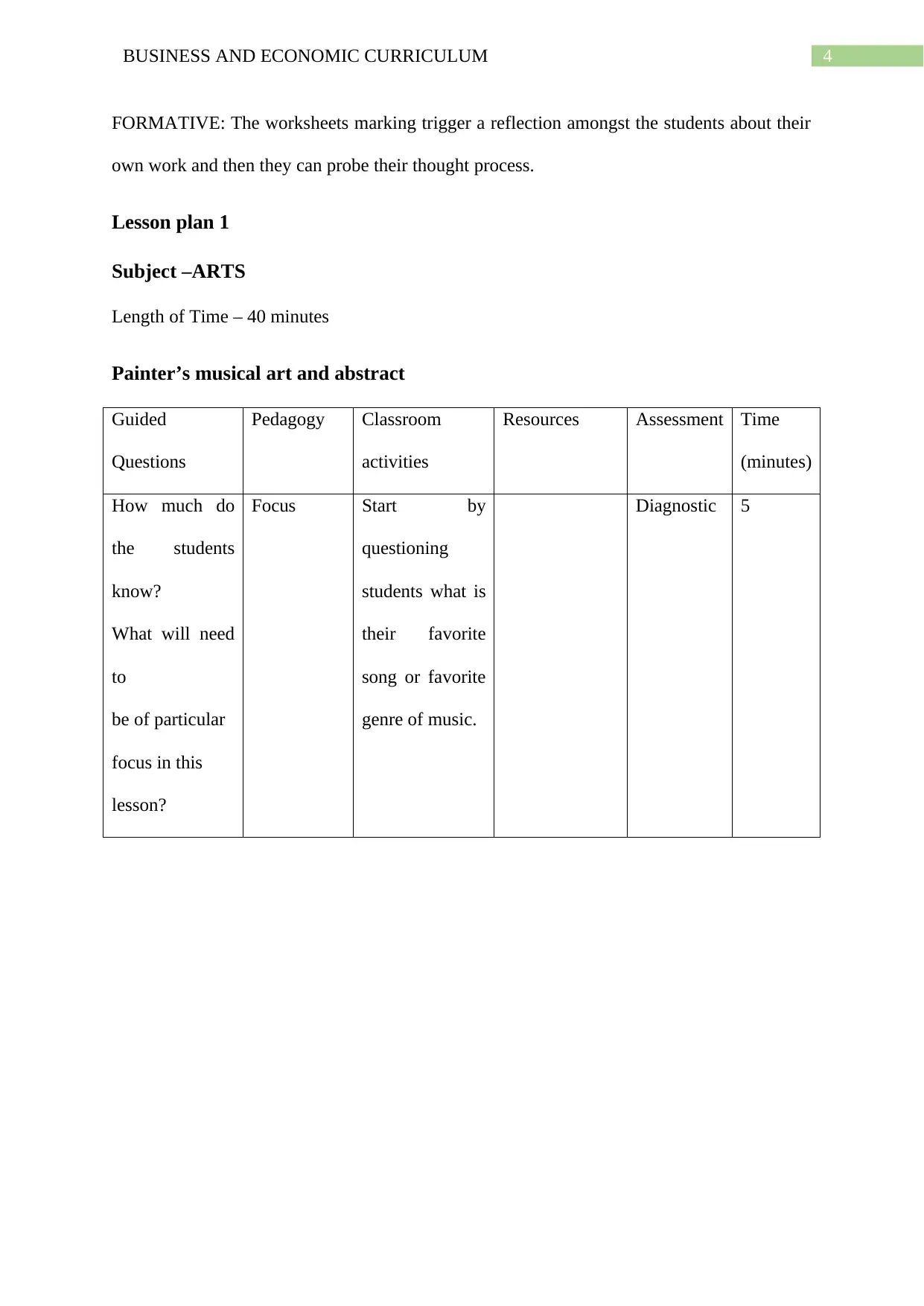
4BUSINESS AND ECONOMIC CURRICULUM
FORMATIVE: The worksheets marking trigger a reflection amongst the students about their
own work and then they can probe their thought process.
Lesson plan 1
Subject –ARTS
Length of Time – 40 minutes
Painter’s musical art and abstract
Guided
Questions
Pedagogy Classroom
activities
Resources Assessment Time
(minutes)
How much do
the students
know?
What will need
to
be of particular
focus in this
lesson?
Focus Start by
questioning
students what is
their favorite
song or favorite
genre of music.
Diagnostic 5
FORMATIVE: The worksheets marking trigger a reflection amongst the students about their
own work and then they can probe their thought process.
Lesson plan 1
Subject –ARTS
Length of Time – 40 minutes
Painter’s musical art and abstract
Guided
Questions
Pedagogy Classroom
activities
Resources Assessment Time
(minutes)
How much do
the students
know?
What will need
to
be of particular
focus in this
lesson?
Focus Start by
questioning
students what is
their favorite
song or favorite
genre of music.
Diagnostic 5
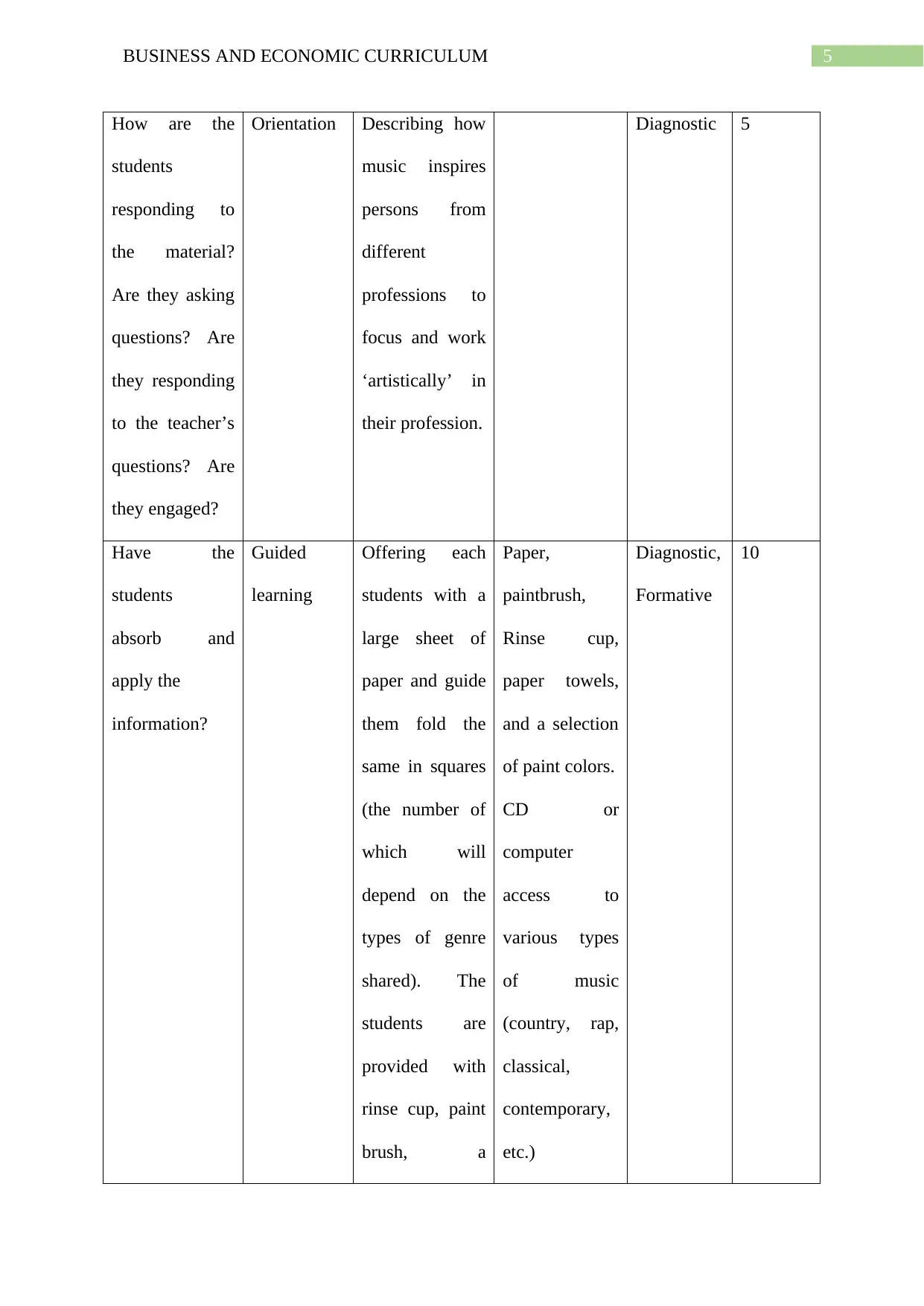
5BUSINESS AND ECONOMIC CURRICULUM
How are the
students
responding to
the material?
Are they asking
questions? Are
they responding
to the teacher’s
questions? Are
they engaged?
Orientation Describing how
music inspires
persons from
different
professions to
focus and work
‘artistically’ in
their profession.
Diagnostic 5
Have the
students
absorb and
apply the
information?
Guided
learning
Offering each
students with a
large sheet of
paper and guide
them fold the
same in squares
(the number of
which will
depend on the
types of genre
shared). The
students are
provided with
rinse cup, paint
brush, a
Paper,
paintbrush,
Rinse cup,
paper towels,
and a selection
of paint colors.
CD or
computer
access to
various types
of music
(country, rap,
classical,
contemporary,
etc.)
Diagnostic,
Formative
10
How are the
students
responding to
the material?
Are they asking
questions? Are
they responding
to the teacher’s
questions? Are
they engaged?
Orientation Describing how
music inspires
persons from
different
professions to
focus and work
‘artistically’ in
their profession.
Diagnostic 5
Have the
students
absorb and
apply the
information?
Guided
learning
Offering each
students with a
large sheet of
paper and guide
them fold the
same in squares
(the number of
which will
depend on the
types of genre
shared). The
students are
provided with
rinse cup, paint
brush, a
Paper,
paintbrush,
Rinse cup,
paper towels,
and a selection
of paint colors.
CD or
computer
access to
various types
of music
(country, rap,
classical,
contemporary,
etc.)
Diagnostic,
Formative
10
⊘ This is a preview!⊘
Do you want full access?
Subscribe today to unlock all pages.

Trusted by 1+ million students worldwide
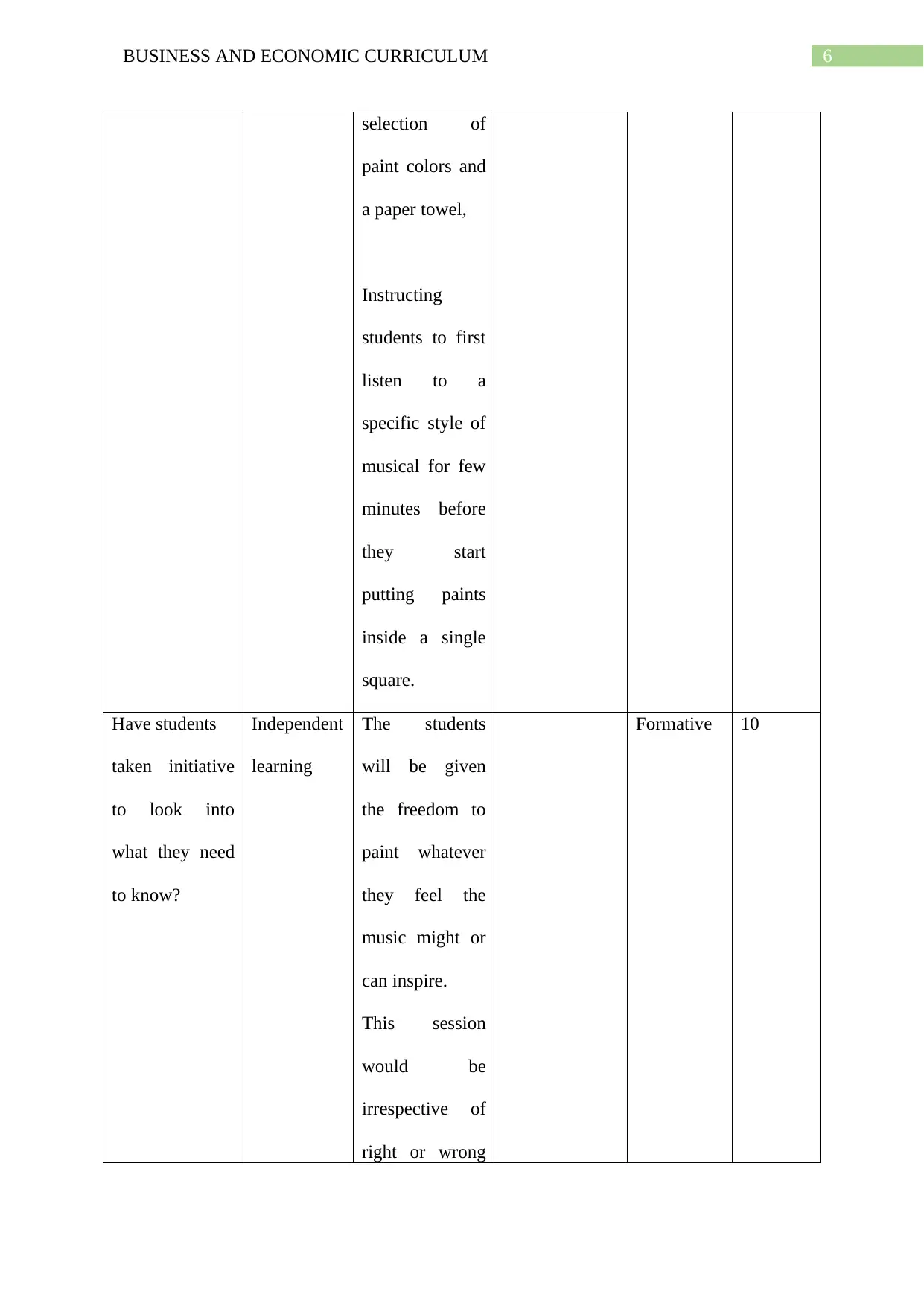
6BUSINESS AND ECONOMIC CURRICULUM
selection of
paint colors and
a paper towel,
Instructing
students to first
listen to a
specific style of
musical for few
minutes before
they start
putting paints
inside a single
square.
Have students
taken initiative
to look into
what they need
to know?
Independent
learning
The students
will be given
the freedom to
paint whatever
they feel the
music might or
can inspire.
This session
would be
irrespective of
right or wrong
Formative 10
selection of
paint colors and
a paper towel,
Instructing
students to first
listen to a
specific style of
musical for few
minutes before
they start
putting paints
inside a single
square.
Have students
taken initiative
to look into
what they need
to know?
Independent
learning
The students
will be given
the freedom to
paint whatever
they feel the
music might or
can inspire.
This session
would be
irrespective of
right or wrong
Formative 10
Paraphrase This Document
Need a fresh take? Get an instant paraphrase of this document with our AI Paraphraser
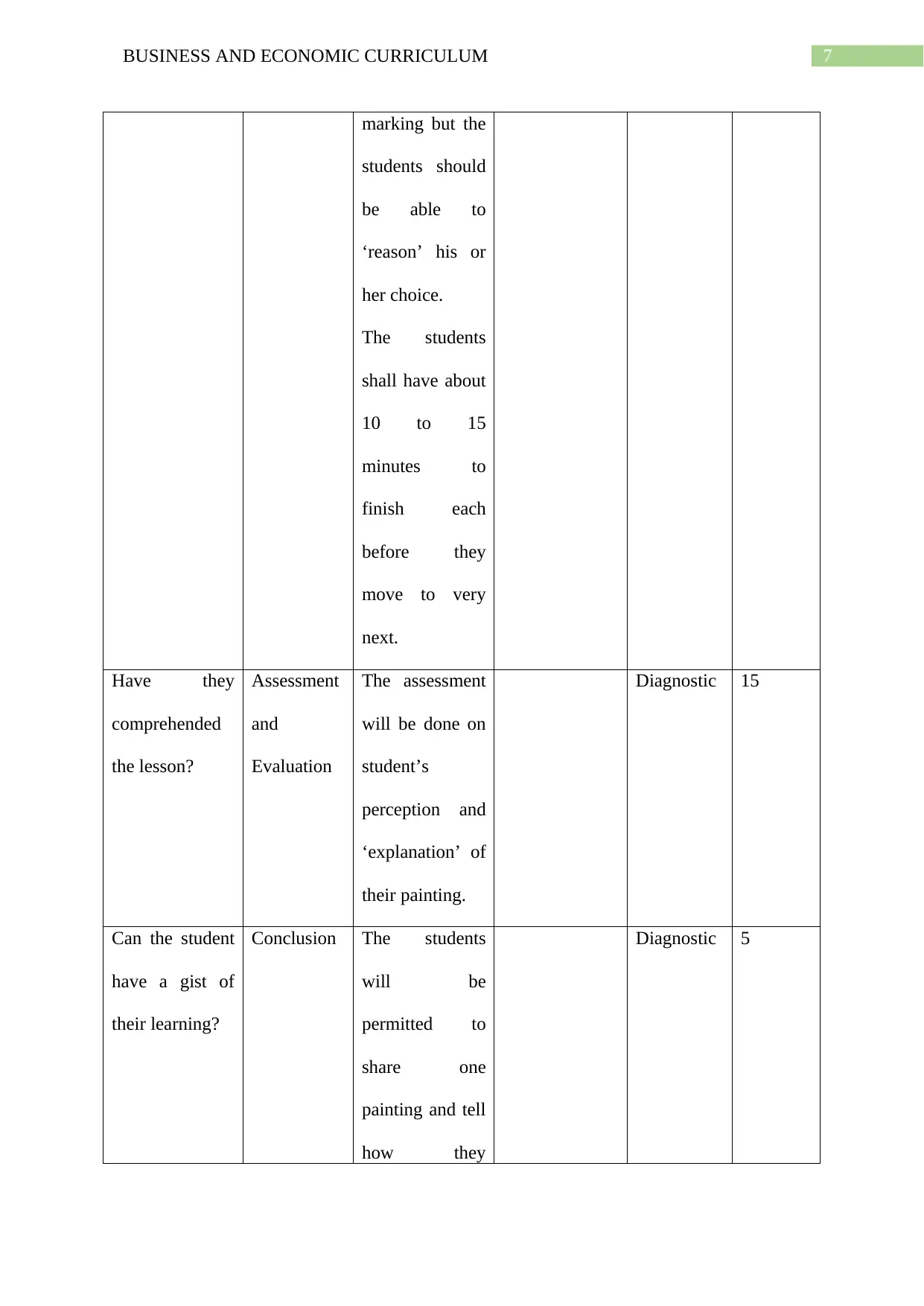
7BUSINESS AND ECONOMIC CURRICULUM
marking but the
students should
be able to
‘reason’ his or
her choice.
The students
shall have about
10 to 15
minutes to
finish each
before they
move to very
next.
Have they
comprehended
the lesson?
Assessment
and
Evaluation
The assessment
will be done on
student’s
perception and
‘explanation’ of
their painting.
Diagnostic 15
Can the student
have a gist of
their learning?
Conclusion The students
will be
permitted to
share one
painting and tell
how they
Diagnostic 5
marking but the
students should
be able to
‘reason’ his or
her choice.
The students
shall have about
10 to 15
minutes to
finish each
before they
move to very
next.
Have they
comprehended
the lesson?
Assessment
and
Evaluation
The assessment
will be done on
student’s
perception and
‘explanation’ of
their painting.
Diagnostic 15
Can the student
have a gist of
their learning?
Conclusion The students
will be
permitted to
share one
painting and tell
how they
Diagnostic 5
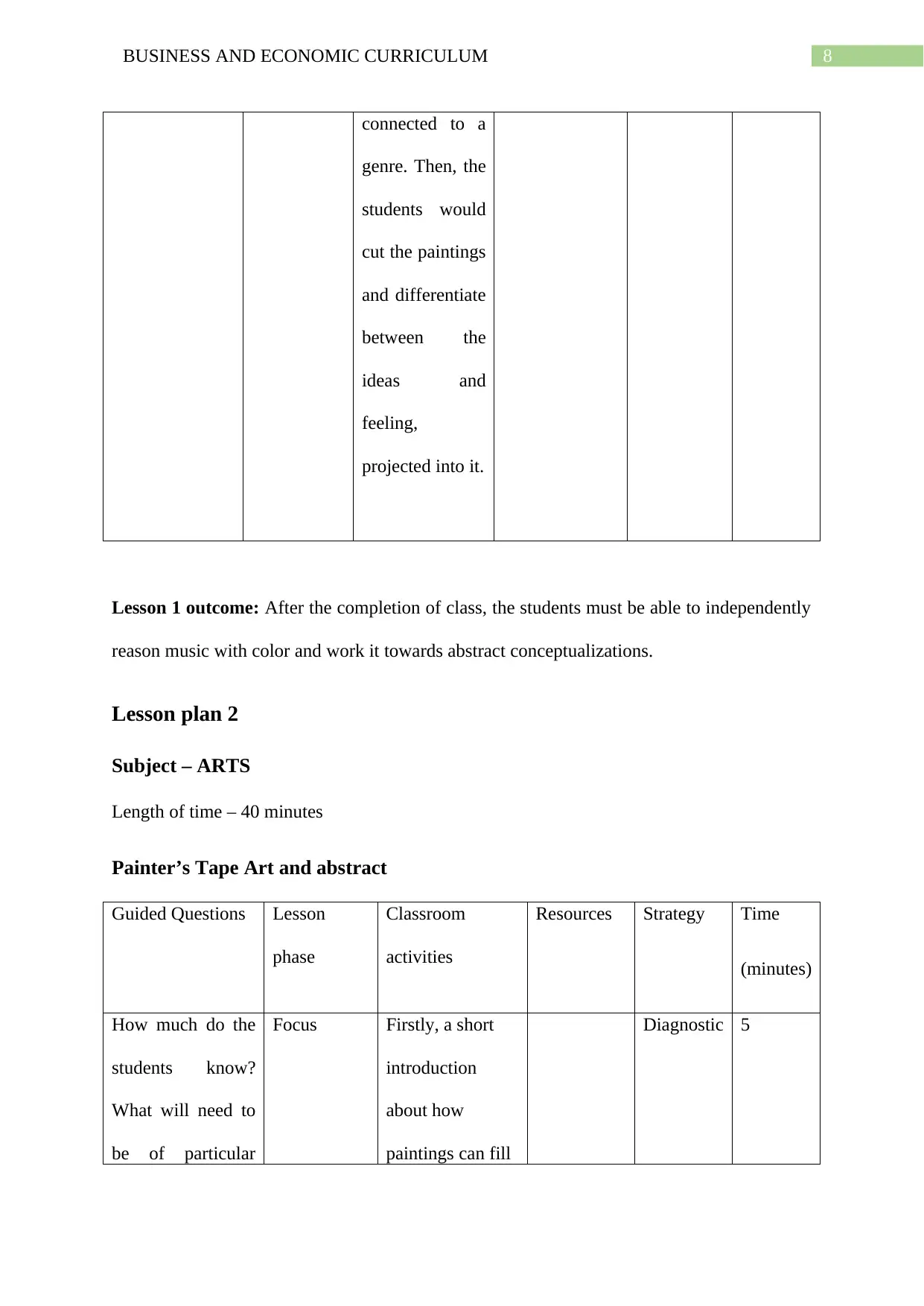
8BUSINESS AND ECONOMIC CURRICULUM
connected to a
genre. Then, the
students would
cut the paintings
and differentiate
between the
ideas and
feeling,
projected into it.
Lesson 1 outcome: After the completion of class, the students must be able to independently
reason music with color and work it towards abstract conceptualizations.
Lesson plan 2
Subject – ARTS
Length of time – 40 minutes
Painter’s Tape Art and abstract
Guided Questions Lesson
phase
Classroom
activities
Resources Strategy Time
(minutes)
How much do the
students know?
What will need to
be of particular
Focus Firstly, a short
introduction
about how
paintings can fill
Diagnostic 5
connected to a
genre. Then, the
students would
cut the paintings
and differentiate
between the
ideas and
feeling,
projected into it.
Lesson 1 outcome: After the completion of class, the students must be able to independently
reason music with color and work it towards abstract conceptualizations.
Lesson plan 2
Subject – ARTS
Length of time – 40 minutes
Painter’s Tape Art and abstract
Guided Questions Lesson
phase
Classroom
activities
Resources Strategy Time
(minutes)
How much do the
students know?
What will need to
be of particular
Focus Firstly, a short
introduction
about how
paintings can fill
Diagnostic 5
⊘ This is a preview!⊘
Do you want full access?
Subscribe today to unlock all pages.

Trusted by 1+ million students worldwide
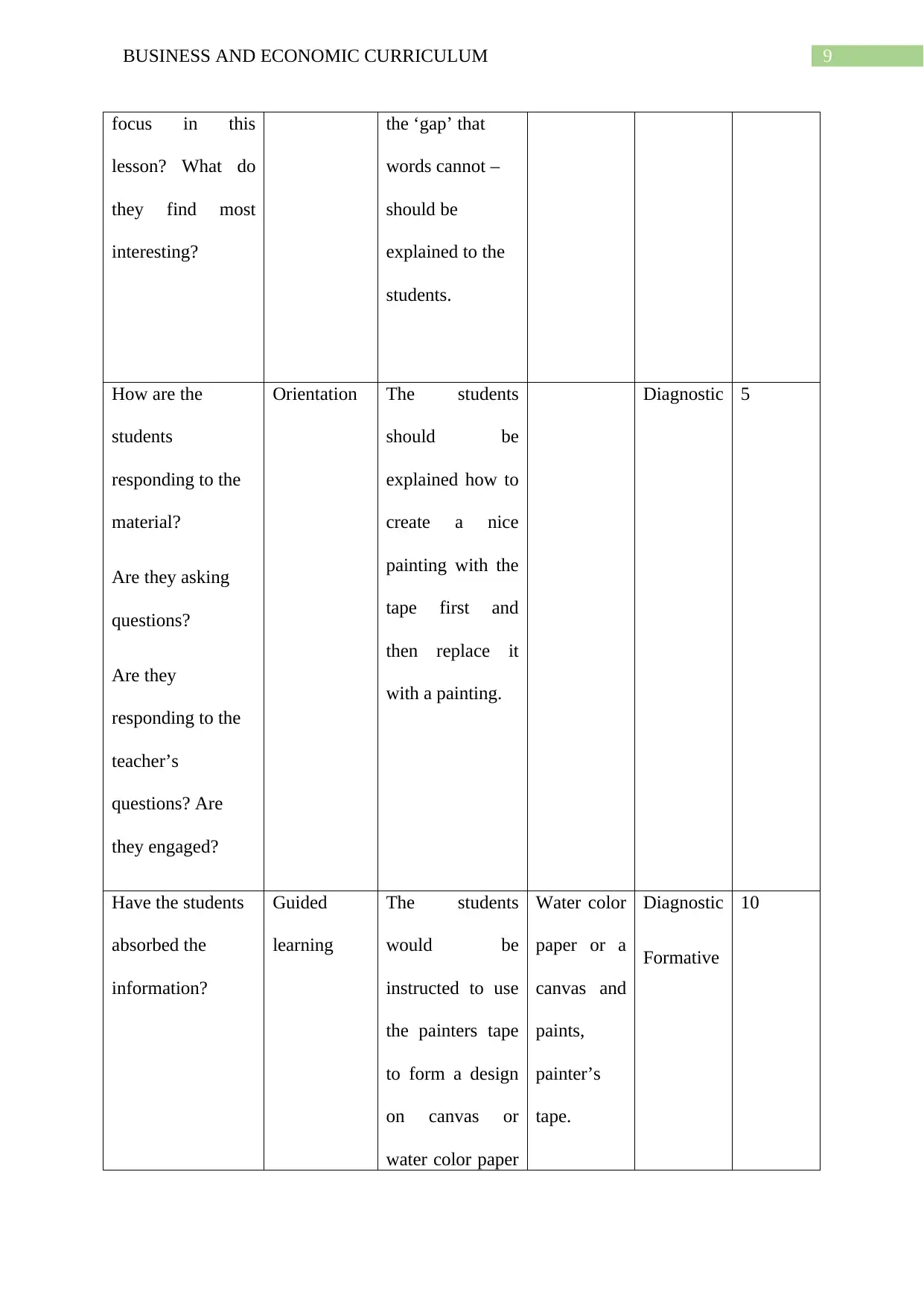
9BUSINESS AND ECONOMIC CURRICULUM
focus in this
lesson? What do
they find most
interesting?
the ‘gap’ that
words cannot –
should be
explained to the
students.
How are the
students
responding to the
material?
Are they asking
questions?
Are they
responding to the
teacher’s
questions? Are
they engaged?
Orientation The students
should be
explained how to
create a nice
painting with the
tape first and
then replace it
with a painting.
Diagnostic 5
Have the students
absorbed the
information?
Guided
learning
The students
would be
instructed to use
the painters tape
to form a design
on canvas or
water color paper
Water color
paper or a
canvas and
paints,
painter’s
tape.
Diagnostic
Formative
10
focus in this
lesson? What do
they find most
interesting?
the ‘gap’ that
words cannot –
should be
explained to the
students.
How are the
students
responding to the
material?
Are they asking
questions?
Are they
responding to the
teacher’s
questions? Are
they engaged?
Orientation The students
should be
explained how to
create a nice
painting with the
tape first and
then replace it
with a painting.
Diagnostic 5
Have the students
absorbed the
information?
Guided
learning
The students
would be
instructed to use
the painters tape
to form a design
on canvas or
water color paper
Water color
paper or a
canvas and
paints,
painter’s
tape.
Diagnostic
Formative
10
Paraphrase This Document
Need a fresh take? Get an instant paraphrase of this document with our AI Paraphraser
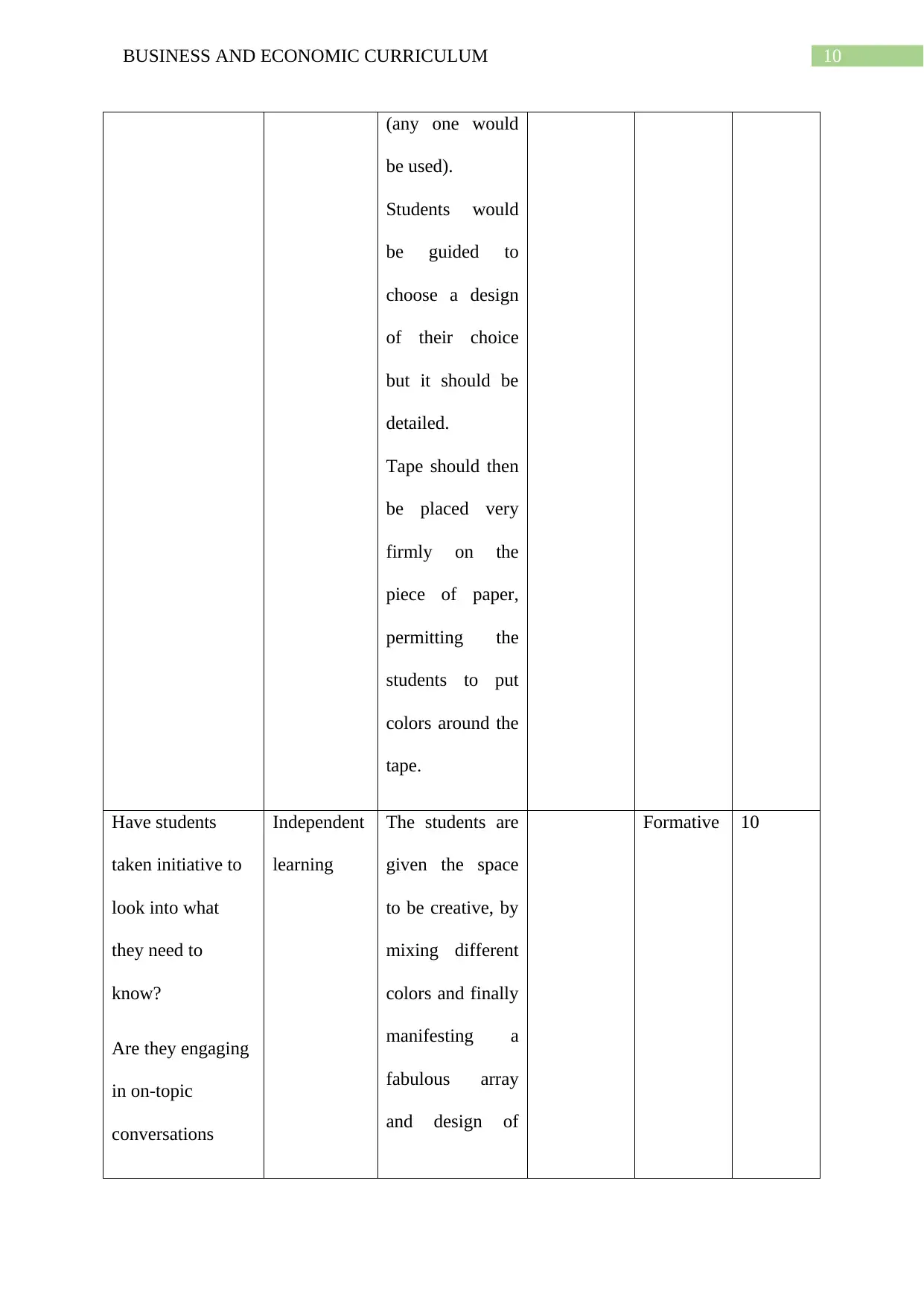
10BUSINESS AND ECONOMIC CURRICULUM
(any one would
be used).
Students would
be guided to
choose a design
of their choice
but it should be
detailed.
Tape should then
be placed very
firmly on the
piece of paper,
permitting the
students to put
colors around the
tape.
Have students
taken initiative to
look into what
they need to
know?
Are they engaging
in on-topic
conversations
Independent
learning
The students are
given the space
to be creative, by
mixing different
colors and finally
manifesting a
fabulous array
and design of
Formative 10
(any one would
be used).
Students would
be guided to
choose a design
of their choice
but it should be
detailed.
Tape should then
be placed very
firmly on the
piece of paper,
permitting the
students to put
colors around the
tape.
Have students
taken initiative to
look into what
they need to
know?
Are they engaging
in on-topic
conversations
Independent
learning
The students are
given the space
to be creative, by
mixing different
colors and finally
manifesting a
fabulous array
and design of
Formative 10
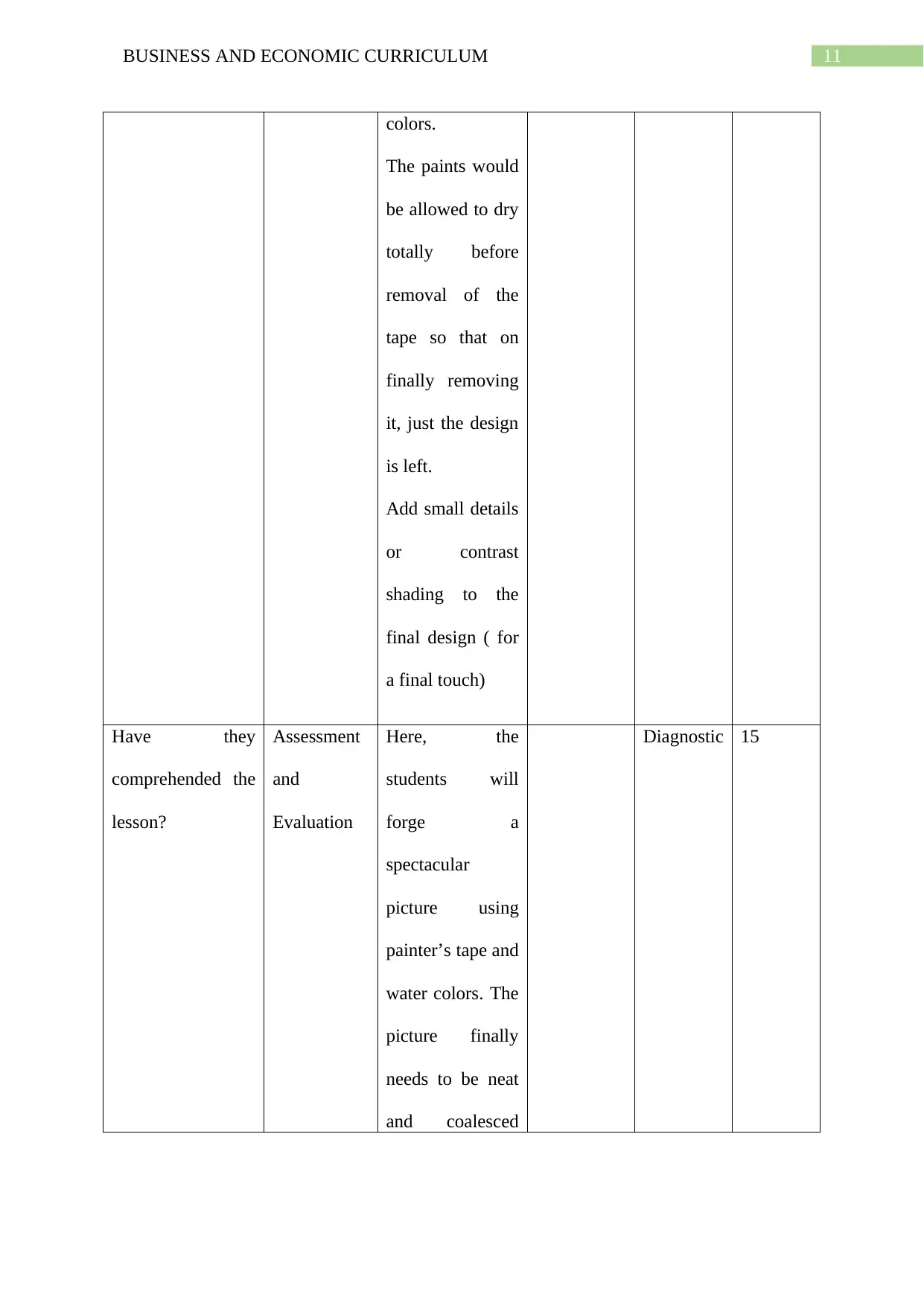
11BUSINESS AND ECONOMIC CURRICULUM
colors.
The paints would
be allowed to dry
totally before
removal of the
tape so that on
finally removing
it, just the design
is left.
Add small details
or contrast
shading to the
final design ( for
a final touch)
Have they
comprehended the
lesson?
Assessment
and
Evaluation
Here, the
students will
forge a
spectacular
picture using
painter’s tape and
water colors. The
picture finally
needs to be neat
and coalesced
Diagnostic 15
colors.
The paints would
be allowed to dry
totally before
removal of the
tape so that on
finally removing
it, just the design
is left.
Add small details
or contrast
shading to the
final design ( for
a final touch)
Have they
comprehended the
lesson?
Assessment
and
Evaluation
Here, the
students will
forge a
spectacular
picture using
painter’s tape and
water colors. The
picture finally
needs to be neat
and coalesced
Diagnostic 15
⊘ This is a preview!⊘
Do you want full access?
Subscribe today to unlock all pages.

Trusted by 1+ million students worldwide
1 out of 24
Related Documents
Your All-in-One AI-Powered Toolkit for Academic Success.
+13062052269
info@desklib.com
Available 24*7 on WhatsApp / Email
![[object Object]](/_next/static/media/star-bottom.7253800d.svg)
Unlock your academic potential
Copyright © 2020–2025 A2Z Services. All Rights Reserved. Developed and managed by ZUCOL.





